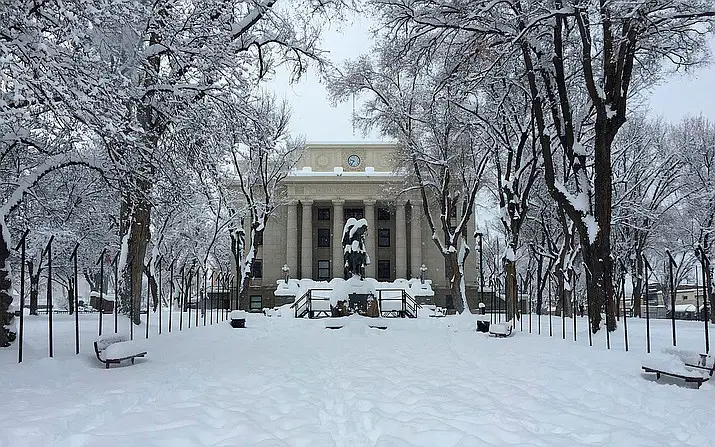Nestled between the Mingus and Bradshaw Mountain ranges in Yavapai County, Arizona, lies the idyllic town of Prescott Valley. This article seeks to decode the intricate dance of Prescott Valley weather by month, shedding light on its uniqueness and drawing on information that can benefit locals, tourists, and weather enthusiasts alike.

Prescott Valley’s location contributes significantly to its unique weather patterns. Understanding the area’s climate nuances can greatly enhance outdoor planning, be it for local residents planning their garden planting schedules or tourists aiming to make the most of their visit. Knowing what to expect, after all, allows for better preparation.
Weather Characteristics
Before we embark on our month-by-month journey, it’s helpful to grasp some general traits of Prescott Valley’s weather. The town, located over a mile high in altitude, experiences a semi-arid climate according to the Köppen classification, characterized by warm to hot summers and mild winters. These climatic patterns contribute to making Prescott Valley an engaging place to live and visit.
Each season in Prescott Valley brings its charm. Spring typically features mild temperatures and occasional rainfall, ideal for outdoor activities. Summer, while warm, often has afternoon thunderstorms due to the North American monsoon.
Fall brings crisp air and changing foliage, while winter, though mild by many standards, can occasionally see a dusting of snow. These seasonal shifts will be further dissected as we explore each month’s specific weather trends.
January
We begin our journey in January, the coldest month in Prescott Valley. Temperatures during this month can drop to around freezing, with daily highs averaging around 55°F. Don’t be surprised if you encounter snow – it’s not uncommon during January, though the quantities are generally small and short-lived.
Despite the chill, the sun frequently makes appearances, keeping the overall climate bearable. Be sure to pack warm clothing if visiting during this month, as cold snaps can occur. The crisp, clear air, however, offers brilliant starlit nights and sunny winter days, painting the town with a unique winter charm.
February
February signals the gradual transition from winter to spring. While nights can still be chilly, the overall temperature begins to climb slightly, with average daily highs reaching around 60°F. The frequency of snowfall reduces compared to January, making way for the early signs of spring.
The melting snow and the slowly warming temperatures set the stage for a beautiful transformation in the valley. When planning for February, remember to pack layers, as day and night temperatures can differ significantly. Also, keep an umbrella handy for the occasional showers that help usher in the spring blooms.

March
The full onset of spring can be witnessed in March. As per NOAA data, average high temperatures hover around 65°F, though early mornings and evenings can remain cool. Rainfall during March can vary, with some years seeing higher precipitation levels than others.
March weather in Prescott Valley presents an ideal time for outdoor exploration. The local flora begins to bloom, adding an extra layer of beauty to the landscapes. Layered clothing is still advised for this transitional period, especially if you plan on enjoying early-morning hikes or late-evening strolls under the stars.
April
April sees the continuation of spring, with further warming temperatures. Average highs now reach into the 70s, and rainfall is typically lower than in March. This decrease in precipitation leads to more sunny days, brightening the town with clear, blue skies.
April’s inviting climate brings forth an array of outdoor events in Prescott Valley. The weather also encourages local wildlife activity, so keep your eyes peeled for a variety of bird species and other fauna. A light jacket may still come in handy for cooler evenings, but during the day, be ready to bask in the comfortable warmth of the Arizona sun.
May
May in Prescott Valley marks the transition into summer. Temperatures climb noticeably, with average highs reaching the 80s. Rainfall is typically low, paving the way for mostly sunny days.
Outdoor enthusiasts, this is your time to shine! The sunny, warm days make for excellent hiking, bird-watching, and picnicking opportunities. Just remember to stay hydrated and wear sunscreen to protect against the intensifying sun. Layers are less crucial this time of year, but having a light sweater for evening activities can be useful.
June
Summer is in full swing come June. With temperatures often surpassing 90°F, it’s one of the warmest months in Prescott Valley. However, as you might learn from a local weather station, Prescott Valley is cooler than many parts of Arizona, thanks to its higher altitude.

While the days are hot, they’re usually quite dry, making the heat more bearable. Additionally, the nights often provide refreshing relief from the day’s heat. Remember to pack lightweight, breathable clothing if you’re visiting in June, and sunscreen is a must. Don’t forget your water bottle, either – staying hydrated is crucial in this dry heat.
July
July continues the summer’s heat but also ushers in the North American Monsoon season. This means there’s a higher likelihood of afternoon thunderstorms, which can bring refreshing, if brief, respite from the warmth. Temperatures during the day can still reach into the 90s, while nights are comfortably cooler.
These summer monsoons bring an exciting dynamic to Prescott Valley’s weather, transforming the landscape and offering some stunning cloud formations for the keen-eyed photographer. If you’re planning outdoor activities, it’s wise to keep an eye on the weather forecast for potential afternoon storms. When packing, include a rain jacket along with your summer wear.
August
In August, the monsoon season continues, meaning the potential for afternoon thunderstorms persists. However, the average high temperature begins to decrease slightly, marking the gradual transition to fall. This month can be quite humid compared to the dry heat of June.
Despite the humidity and potential for rain, August remains a vibrant month in Prescott Valley. The monsoon rains often lead to an explosion of plant life, making the landscapes lush and colorful. As with July, having a rain jacket at hand can be beneficial, and continue to protect yourself from the sun when it’s out and shining.
September
September welcomes the arrival of fall in Prescott Valley. The temperatures start to become milder, and the monsoon season typically wraps up by the end of the month. This leaves the town with warm days, cooler nights, and a reduction in humidity.
September is often considered one of the best months to visit Prescott Valley, with its pleasant temperatures and lower rainfall. The changing foliage adds a beautiful array of colors to the landscape, and the weather is typically excellent for a range of outdoor activities. Pack a mix of short and long-sleeved clothing to accommodate the variable temperatures.
October
October fully embraces the fall season in Prescott Valley. Temperatures continue to cool, with daytime highs averaging in the 70s and nighttime temperatures dipping lower. Rainfall is typically low in October, providing many sunny days to enjoy the crisp fall air.
The cooler temperatures and changing foliage make October an attractive month for outdoor activities. Hiking, camping, and wildlife watching are especially rewarding during this month. Make sure to pack a jacket for the cooler evenings and enjoy the beautiful fall scenery that Prescott Valley has to offer.
November
As November rolls in, Prescott Valley starts hinting at the upcoming winter. Temperatures continue their descent, with daytime highs averaging around 60°F and nighttime temperatures often dropping below freezing. Despite the cooler temperatures, November remains relatively dry, maintaining the trend of sunny days.
With the shift toward colder weather, clothing layers become essential again. Yet, the clear, crisp days offer beautiful views of the surrounding mountains, often snow-capped by this time of year. Whether you’re a local or a visitor, November’s weather offers a quiet and serene atmosphere that many find appealing.
December
December marks the start of winter in Prescott Valley. This month sees some of the coldest temperatures of the year, similar to January. Snow can fall during December, though it’s typically not heavy and melts relatively quickly.
Despite the colder weather, December holds a certain charm. The possibility of a light dusting of snow, the chilly but often sunny days, and the anticipation of the holidays make it a special time in Prescott Valley. Pack warmly if you plan to visit during December, and be prepared for potentially icy conditions.

Understanding Weather Data
Weather forecasting is a complex science involving a wide range of terms. To fully appreciate the nuances of Prescott Valley’s weather, it’s helpful to understand some common meteorological terminology. The National Weather Service’s glossary is an excellent resource for this.
Reliable weather data is crucial for accurate forecasting. Weather.com, the National Weather Service, and local news stations are all reputable sources of weather information for Prescott Valley. Remember, understanding the data can greatly enhance your ability to plan and prepare for various weather conditions.
The Impacts of Weather
The influence of weather on local activities and tourism in Prescott Valley is significant. Warmer months bring a surge in outdoor activities, such as hiking, camping, and bird watching. The cooler, winter months offer other attractions, such as winter sports or simply enjoying the town’s festive decorations.
Weather also greatly affects local flora and fauna. The monsoon season, for instance, encourages the growth of local plant life, transforming the landscape and providing food for various wildlife species. The Prescott Valley Audubon Society can provide more information about the local fauna and how it’s influenced by weather patterns.
FAQs:
Before we wrap up, let’s address some frequently asked questions about Prescott Valley’s weather.
What is the hottest month in Prescott Valley?
July is typically the hottest month, with average high temperatures reaching the low 90s.
What is the coldest month in Prescott Valley?
January is generally the coldest month, with average lows dropping near freezing.
How often does it rain in Prescott Valley?
Rainfall varies throughout the year but is most common during the monsoon season from July to September.
What should I pack when visiting Prescott Valley during [Month]?
This depends on the month. Generally, light clothing is suitable for summer, while layers are needed for winter. Transitional months may require a mix of both.
How does the weather in Prescott Valley compare to other cities in Arizona?
Being at a higher altitude, Prescott Valley is generally cooler than lower-altitude cities in Arizona, like Phoenix or Tucson. However, it’s warmer than places at higher altitudes, like Flagstaff.
Summary
The climate in Prescott Valley is a captivating blend of warm summers, mild winters, and distinct monsoon seasons, with each month offering its unique weather characteristics. This variety makes the town a delightful place to live and visit, with something to offer everyone, whether you’re a sun-seeker, a snow lover, or a rain enthusiast.
Understanding the Prescott Valley weather by month will help you plan your activities and fully enjoy everything this charming Arizona town has to offer.



Leave a Comment
You must be logged in to post a comment.